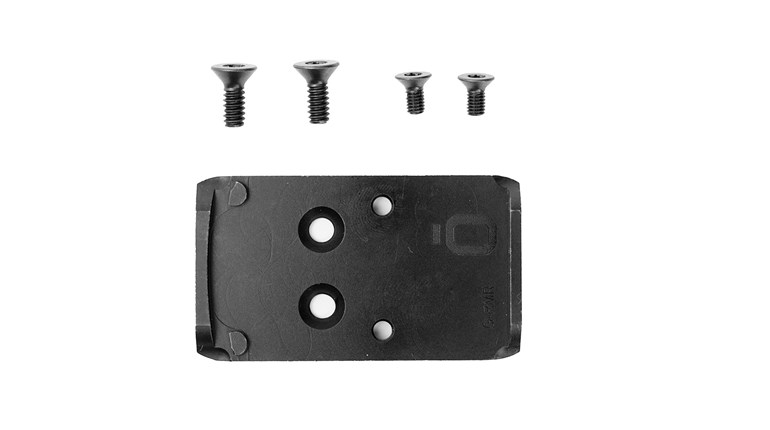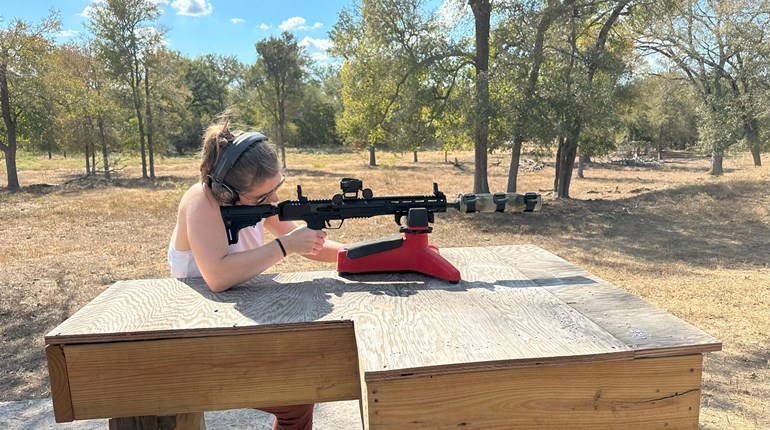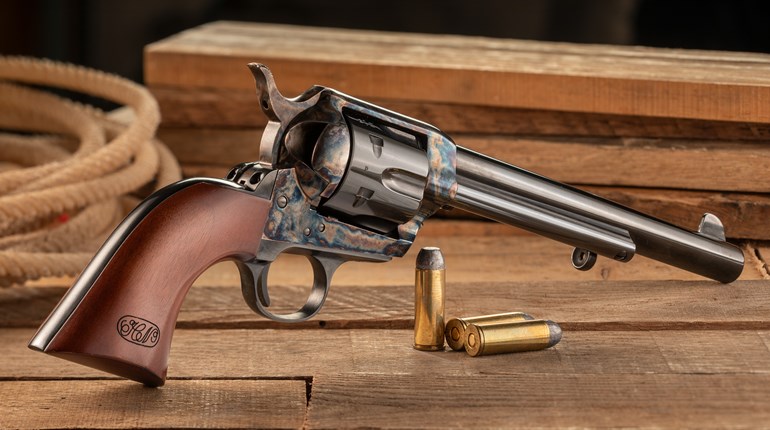
Carbon Arms “Feather” Handguard
Fair warning: One of these may prove a very difficult thing to own. The only saving tactic or grace will be if you only shoot your MSR/ARs off a bench/rest or bipod: If that’s the case, you may only notice that it’s stout and handsome, just as promised. But if you tote that rifle much, or run and shoot it, you may well be doomed.
Unless you’ve gone to a lot of trouble, your current handguard is between 20 and 30 percent heavier than the Feather—and maybe more—and it’s hard to believe how much lighter and quicker the front of the gun will seem with a Carbon Arms out there.
That “running and shooting” business may be why this is such a nifty handguard—we know for a fact that the Carbon Arms folks shoot a lot. The result is a clever (and removable) attachment method, and nothing you don’t need to weaken or compromise the carbon fiber (cooling slots look neat, for instance, but don’t help much and weaken the tube).
As if the weight loss weren’t enough—and the fiber itself not snazzy enough—Carbon Arms will customize one for you in terms of both color (we saw six on their website, but there may be more) and texture. And .308/AR-10? You betcha.
Our own experience running one is now edging up near 3,000 rounds, and we haven’t a single negative to report. Our sample was black, which suited our rifle (and our cosmetic tastes don’t run to the elaborate, anyway). We’d like to try a texture, but have no complaints here either—the diameter and hand position we get is plenty secure. We did this along with a sight change and whacked a half-pound off our rifle, and can’t say for sure which weight reduction is more substantive. But oooo-ahhhh factor is consistent: Everybody seems able to swing it in a hurry.

That’s where owning just one becomes a problem. We figure we need two more and counting, but Mrs. Guns & Gear may want us to be mas despacio in acquisition. (Her prudence can be so disheartening.)
You may want to hunt up a friend who already has one, but we think this is one of those things to simply order. If a faster swing or just a lighter rifle is on your spring and summer to-do (or any other) list, it’s hard to imagine not liking the Feather. If you plan a self-install, pay attention to the instructions. There’s nothing esoteric, really, but the DIYer needs to restrain him- or herself where carbon fiber is concerned—the “do”s are easy and the “don’t”s consequential.
Contact Carbon Arms at www.carbonarms.us. MSRP of the Feather Handguard is $190-285.
Elite Tactical Systems “Glock” Magazines
A question: Why would anybody expend time and effort duplicating what is arguably the world’s best all-around handgun magazine—particularly when new exemplars of same are regularly available for less than $30?
Perhaps because “best” may not yet be “perfect,” is our suggestion. Mind, we’re the first to admit that this is a tough mountain to climb: We have first-generation Glock mag bodies, followers and bases we’re still using 20-odd years after purchase with no issues. We grant that polymer from polymer drops don’t seem as fast as metal from metal, or even metal from polymer, but 32 ft/sec/sec still works fast enough that we never seem to find anything in the way when we’re in a hurry on a mag swap.
Those polymer-enclosed steel liners are pretty trouble-free, too: With models switching in and out over the years, we reckon we’ve owned at least 100 Glock magazines, yet we’ve never lost one to feed lip deformation. Period.
Well done, Glock.
Now, to the bad news: Line up several Glock mags and look at the backs, and you’ll discover the antecedents of an annoying shortcoming—the “witness” holes. These well-intentioned little buggers—neatly numbered and carefully (we suppose) positioned—are a perversely unreliable method of confirming round count. In anything but the very best light, and sometimes not even then, they are a plus or minus one round proposition at best. Quite apparently our dissatisfaction is not unique—witness, so to speak, the fact that they’ve even moved over the years in an effort for greater accuracy. They are better too, but that doesn’t help much with the magazines already acquired.
Enter Elite Tactical Systems Group. If you’re an AR/MSR guy or gal, you likely know of ETS and their translucent, couple-able, Stoner-pattern magazines. Being in “magazine jail” by virtue of our domicile, we’ve had limited opportunities to try these while visiting out of state, but have no complaints in those trials.
The same technology is now ramping up for Glocks of huge variety, and we’re impressed. Right off is the obvious benefit of the translucent magazine body. At the very least, it ends forever the need to angle and/or fumble the magazine into a position that gets enough light in those witness holes to know where round count ends and “oh, %@&#!” begins.

Another plus is the clear avoidance of “our way or the highway”: We tried just about every Glock magazine or pistol accouterment we have with the ETSes with 100 percent success—alternative floorplates/basepads (including “factory”), replacement springs, and magwells ran perfectly. Though our model was for a G19, we ran it in a G23 conversion (to 9mm), and in a pair of G26 sub-compacts of different Gens to the tune of several hundred rounds. The worst problem we had were two failures to lock the slide open after the final shot. (We get this on rare occasions even with factory mags, so it hardly lit us up.)
PCCers note: If you’re having trouble finding native big sticks, we can tell you the G19 samples ran fine in our in-house pistol caliber carbine (a JP). There’s no reason that we could see to think the longer versions won’t run well in yours, too.
We also encountered no issues with extremely varied fodder: .985 to 1.155 OALs from 100 to 158 grains ran trouble-free.
Also on this theme are a tremendous variety of available but non-standard round counts. Competitors will like 140 and 170mm lengths, and even single stack users get some help with body lengths up to 10 rounds for the G43 due shortly.
If there’s a gripe, it’s really modest: Our pal Fox rightly observed that a visual mark of partial load states could have been molded in so that an explicit count wouldn’t always be required. He’s right: Five, 10 (or more) round hacks of some kind would make these even better.
As if this weren’t enough, the money part will put a smile on your face too: The “big sticks” (up to 31 rounds in 9mm, and 24 in .40 S&W) are $22 bucks, and standard capacities are a paltry $18.
We’ll keep up the pressure on our samples and get back to you, but a “jolly well done, ETS,” seems due.
Contact Elite Tactical Systems at www.etsgroup.us. MSRP for ETS magazines is $17-22.
Light/Short Build Update
If you have been following our build, we have an update. It’s all assembled, and hand cycling tests have now been confirmed by live fire. So far, so good, we’d say: Even ho-hum ammo is hovering at just above 1 MOA. If we ever get a break from positively gnarly wind (it’s blowing over our cameras and chrono with annoying regularity), we’ll shoot for accuracy and speed. Thanks to SinterFire’s Joe Kugler and our friends at Gorilla Ammunition, our hopes are high for both.
And yes: We’ll publish a complete parts list, too. Stay tuned.
Part 1 Part 2 Part 3 Part 4 Part 5 Part 6 Part 7 Part 8 Part 9 Part 10 Part 11
Frank Winn has been studying arms and their relationship to tyranny, meaningful liberty and personal security all his adult life. He has also been a competitive shooter and firearms safety/shooting instructor for more than 20 years, though he won’t admit how many more than 20.


































